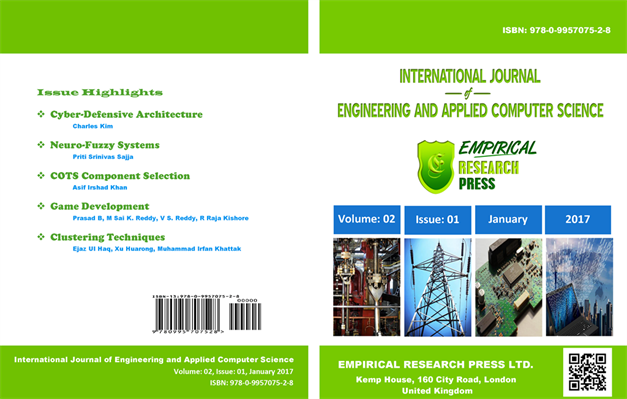



Volume: 02, Issue: 01, January 2017

Content

h-index
6
Charles Kim

i10-index
4
Impact Factor
C. Kim, “Cyber-Defensive Architecture for Networked Industrial Control Systems,” International Journal of Engineering and Applied Computer Science, vol. 02, no. 01, pp. 01–09, Jan. 2017. https://doi.org/10.24032/ijeacs/0201/01
2.35
Abstract—This paper deals with the inevitable consequence of the convenience and efficiency we benefit from the open, networked control system operation of safety-critical applications: vulnerability to such system from cyber-attacks. Even with numerous metrics and methods for intrusion detection and mitigation strategy, a complete detection and deterrence of internal code flaws and outside cyber-attacks has not been found and would not be found anytime soon. Considering the ever incompleteness of detection and prevention and the impact and consequence of mal-functions of the safety-critical operations caused by cyber incidents, this paper proposes a new computer control system architecture which assures resiliency even under compromised situations. The proposed architecture is centered on diversification of hardware systems and unidirectional communication from the proposed system in alerting suspicious activities to upper layers. This paper details the architectural structure of the proposed cyber defensive computer control system architecture for power substation applications and its validation in lab experimentation and on a cybersecurity testbed.

Priti Srinivas Sajja

P. S. Sajja, “Computer Aided Development of Fuzzy, Neural and Neuro-Fuzzy Systems,” International Journal of Engineering and Applied Computer Science, vol. 02, no. 01, pp. 10–17, Feb. 2017. https://doi.org/10.24032/ijeacs/0201/02
Abstract—Development of an expert system is difficult because of two challenges involve in it. The first one is the expert system itself is high level system and deals with knowledge, which make is difficult to handle. Second, the systems development is more art and less science; hence there are little guidelines available about the development. This paper describes computer aided development of intelligent systems using modem artificial intelligence technology. The paper illustrates a design of a reusable generic framework to support friendly development of fuzzy, neural network and hybrid systems such as neuro-fuzzy system. The reusable component libraries for fuzzy logic based systems, neural network based system and hybrid system such as neuro-fuzzy system are developed and accommodated in this framework. The paper demonstrates code snippets, interface screens and class libraries overview with necessary technical details.

Asif Irshad Khan

A. I. Khan, “An Elite Model for COTS Component Selection Process,” International Journal of Engineering and Applied Computer Science, vol. 02, no. 01, pp. 18–24, Feb. 2017. https://doi.org/10.24032/ijeacs/0201/03
Abstract—Component-based software development (CBD) promises development of high-quality trustworthy software systems within specified budget and deadline. The selection of the most appropriate component based on specific requirement plays a vital role for high-quality software product. Multi-Agent software (MAS) engineering approach played a crucial role for selection of the most appropriate component based on a specific requirement in a distributed environment. In this paper, multi agent technique is used for component selection. A semi-automated solution to COTS component selection is proposed. It is evident from the result that (MAS) plays an essential role and is suitable for component selection in a distributed environment keeping in view of the system design and testing strategies.

Prasad B, M Sai Kumar Reddy, V Srikanth Reddy, R Raja Kishore

P. B, M. S. K. Reddy, V. S. Reddy, and R. R. Kishore, “Game Development - Bounty Rescuestep,” International Journal of Engineering and Applied Computer Science, vol. 02, no. 01, pp. 25–31, Feb. 2017. https://doi.org/10.24032/ijeacs/0201/04
Abstract—Now a day everyone is having a passion of playing Survival games so, keeping on mind this project gives a best experience on playing the best escaping game. Usually this game consists of very high visual graphics. Ball is the main player in the game designed, the main aim of the player is to hold its life and reach from source to destination by escaping from the different disturbances like obstacle which come in between. Game has many modules mainly Ball control, Checkpoints, Enemy kill and die, Self-destruct, Coin pickup and many other modules. Game has made for all devices like, windows and Mac OS systems. This Game is made by Unity Platform, and programming is with Javascript. Entire game gives a good experience with good Visual Effects.

Ejaz Ul Haq, Xu Huarong, Muhammad Irfan Khattak

E. Ul Haq, X. Huarong, and M. I. Khattak, “A Review of Various Clustering Techniques,” International Journal of Engineering and Applied Computer Science, vol. 02, no. 01, pp. 32–38, Feb. 2017. https://doi.org/10.24032/ijeacs/0201/05
Abstract—Data mining is an integrated field, depicted technologies in combination to the areas having database, learning by machine, statistical study, and recognition in patterns of same type, information regeneration, A.I networks, knowledge-based portfolios, artificial intelligence, neural network, and data determination. In real terms, mining of data is the investigation of provisional data sets for finding hidden connections and to gather the information in peculiar form which are justifiable and understandable to the owner of gather or mined data. An unsupervised formula which differentiate data components into collections by which the components in similar group are more allied to one other and items in rest of cluster seems to be non-allied, by the criteria of measurement of equality or predictability is called process of clustering. Cluster analysis is a relegating task that is utilized to identify same group of object and it is additionally one of the most widely used method for many practical application in data mining. It is a method of grouping objects, where objects can be physical, such as a student or may be a summary such as customer comportment, handwriting. It has been proposed many clustering algorithms that it falls into the different clustering methods. The intention of this paper is to provide a relegation of some prominent clustering algorithms.










